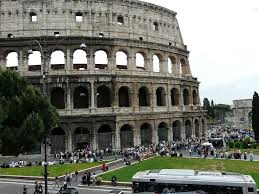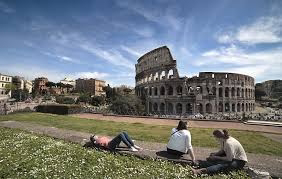The Temple of Artemis at Ephesus, also known as the Artemision , was one of the Seven Wonders of the Ancient World. It was a grand temple dedicated to the Greek goddess Artemis, the goddess of the hunt, fertility, and childbirth. The temple was located in the ancient city of Ephesus , which is now modern-day Turkey . The construction of the temple began in the 6th century BC , during the reign of King Croesus of Lydia. It was designed by the Greek architect Chersiphron and his son Metagenes . The temple was built on a marshy plain near the river Cayster, and it was raised on a platform to prevent flooding. The temple was made of marble and was adorned with sculptures and decorations. The temple was destroyed and rebuilt several times throughout history. The first temple was destroyed by a flood in 550 BC , and it was rebuilt by Croesus . The second temple was destroyed by arson in 356 BC , and it was rebuilt by Alexander the Great. The third te...
The Colosseum, also known as the Flavian Amphitheatre, is an iconic symbol of ancient Rome. This impressive structure is one of the most recognizable landmarks in the world, and it has been a popular tourist destination for centuries. The Colosseum is a testament to the ingenuity and engineering prowess of the ancient Romans, and it is a fascinating glimpse into the past.
History of the Colosseum
The Colosseum was built between 70 and 80 AD, during the reign of the Flavian dynasty. It was commissioned by Emperor Vespasian, who wanted to build a grand amphitheatre that could host public spectacles and games. The Colosseum was completed by his son, Titus, in 80 AD.
The Colosseum was designed to hold up to 80,000 spectators, and it was used for a variety of events, including gladiator battles, animal hunts, and public executions. The amphitheatre was also used for mock sea battles, which were staged using a complex system of water channels and pumps.
Over the centuries, the Colosseum fell into disrepair, and it was used as a quarry for building materials. In the Middle Ages, it was used as a fortress and a church. In the 18th and 19th centuries, the Colosseum was restored and became a popular tourist destination.
Architecture of the Colosseum
The Colosseum is an impressive feat of engineering, and it is considered one of the greatest works of Roman architecture. The amphitheatre is elliptical in shape, and it measures 189 meters long, 156 meters wide, and 50 meters high. The Colosseum is made of stone and concrete, and it is held together by iron clamps.
The Colosseum has four levels, and each level has a different architectural style. The first level is made up of Doric columns, the second level is made up of Ionic columns, and the third level is made up of Corinthian columns. The fourth level is a plain attic, which was used to support the awning that covered the amphitheatre.
The Colosseum also has a complex system of tunnels and chambers, which were used to transport animals, gladiators, and props to the arena. The arena itself was made of wood and covered with sand, which was used to absorb the blood and gore from the battles.
Visiting the Colosseum
Today, the Colosseum is one of the most popular tourist destinations in the world. Visitors can explore the amphitheatre and learn about its history and architecture. The Colosseum also hosts special events, such as concerts and exhibitions.
Visitors can also take a guided tour of the Colosseum, which includes access to the underground chambers and tunnels. The tour provides a fascinating glimpse into the inner workings of the amphitheatre, and it is a must-see for anyone interested in ancient Roman history.
In conclusion, the Colosseum is a remarkable structure that has stood the test of time. It is a testament to the ingenuity and engineering prowess of the ancient Romans, and it is a fascinating glimpse into the past. Whether you are a history buff or just a curious traveler, the Colosseum is a must-see destination that should be on everyone's bucket list.









Comments
Post a Comment